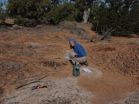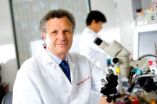(Press-News.org) Last March, researchers at UCLA reported the development of a molecular compound called CLR01 that prevented toxic proteins associated with Parkinson's disease from binding together and killing the brain's neurons.
Building on those findings, they have now turned their attention to Alzheimer's disease, which is thought to be caused by a similar toxic aggregation or clumping, but with different proteins, especially amyloid-beta and tau.
And what they've found is encouraging. Using the same compound, which they've dubbed a "molecular tweezer," in a living mouse model of Alzheimer's, the researchers demonstrated for the first time that the compound safely crossed the blood–brain barrier, cleared the existing amyloid-beta and tau aggregates, and also proved to be protective to the neurons' synapses — another target of the disease — which allow cells to communicate with one another.
The report appears in the current online edition of the journal Brain.
"This is the first demonstration that molecular tweezers work in a mammalian animal model," said Gal Bitan, an associate professor of neurology at UCLA and the senior author of the study. "Importantly, no signs of toxicity were observed in the treated mice. The efficacy and toxicity results support the mechanism of this molecular tweezer and suggest these are promising compounds for developing disease-modifying therapies for Alzheimer's disease, Parkinson's and other disorders."
Molecular tweezers are complex molecular compounds capable of binding to other proteins. Shaped like the letter "C," these compounds wrap around chains of lysine, a basic amino acid that is a constituent of most proteins. Bitan and his colleagues, including Aida Attar, first author of the study and a graduate student in Bitan's lab, have been working with a particular molecular tweezer called CLR01.
In collaboration with scientists at the Università Cattolica in Rome, the researchers, working first in cell cultures, found that CLR01 effectively inhibited a process known as synaptotoxicity, in which clumps of toxic amyloid damage or destroy a neuron's synapses.
Even though synapses in transgenic mice with Alzheimer's may shut down and the mice may lose their memory, upon treatment, they form new synapses and regain their learning and memory abilities.
"For humans, unfortunately, the situation is more problematic because the neurons gradually die in Alzheimer's disease," Bitan said. "That's why we must start treating as early as possible. The good news is that the molecular tweezers appear to have a high safety margin, so they may be suitable for prophylactic treatment starting long before the onset of the disease."
Next, using a radioactive "label," the researchers were able to confirm that the compound had crossed the mouse's blood–brain barrier and was effective in clearing the brain of amyloid-beta and tau aggregates.
"This work shows that molecular tweezers do a number of things — they help to ameliorate multiple pathologic features of Alzheimer's, including amyloid plaques, neurofibrillary tangles and brain inflammation, and our cell culture experiments demonstrated that molecular tweezers block the toxic effect of amyloid-beta on synaptic integrity and communication," Bitan said.
"We call these unique tweezers 'process-specific,' rather than the common protein-specific inhibitors," he added, meaning the compound only attacks the targeted toxic aggregates and not normal body processes. "That's a big deal, because it helps confirm evidence that the molecular tweezers can be used safely, ultimately supporting their development as a therapy for humans."
The next step, Bitan hopes, is to confirm that the tweezers improve memory and not just brain pathology. The researchers say they are working on this question and already have encouraging preliminary data.
###
There were multiple authors on the study in addition to Bitan and Attar. Please see the study for the complete list.
The work was supported by the UCLA Jim Easton Consortium for Alzheimer's Drug Discovery and Biomarker Development; American Health Assistance Foundation grant A2008-350; RJG Foundation grant 20095024; a Cure Alzheimer's Fund grant; individual pre-doctoral National Research Service Award 1F31AG037283; National Institute of Health grant R01AG021975; and a Veteran's Administration Merit Award.
The UCLA Department of Neurology, with over 100 faculty members, encompasses more than 20 disease-related research programs, along with large clinical and teaching programs. These programs cover brain mapping and neuroimaging, movement disorders, Alzheimer's disease, multiple sclerosis, neurogenetics, nerve and muscle disorders, epilepsy, neuro-oncology, neurotology, neuropsychology, headaches and migraines, neurorehabilitation, and neurovascular disorders. The department ranks in the top two among its peers nationwide in National Institutes of Health funding.
For more news, visit the UCLA Newsroom and follow us on Twitter.
Researchers report potential new treatment to stop Alzheimer's disease
Molecular 'tweezers' break up toxic aggregations of proteins in mouse model
2012-11-16
ELSE PRESS RELEASES FROM THIS DATE:
WSU scientists find new way for antibiotic resistance to spread
2012-11-16
PULLMAN, Wash.—Washington State University researchers have found an unlikely recipe for antibiotic resistant bacteria: Mix cow dung and soil, and add urine infused with metabolized antibiotic. The urine will kill off normal E. coli in the dung-soil mixture. But antibiotic-resistant E. coli will survive in the soil to recolonize in a cow's gut through pasture, forage or bedding.
"I was surprised at how well this works, but it was not a surprise that it could be happening," says Doug Call, a molecular epidemiologist in WSU's Paul G. Allen School for Global Animal Health. ...
Young gamers offer insight to teaching new physicians robotic surgery
2012-11-16
What can high school and college-age video game enthusiasts teach young surgeons-in-training?
According to a new study from researchers at the University of Texas Medical Branch at Galveston (UTMB) – a world leader in minimally invasive and robotic surgery – the superior hand-eye coordination and hand skills gained from hours of repetitive joystick maneuvers mimic the abilities needed to perform today's most technologically-advanced robotic surgeries.
To offer insight on how best to train future surgeons, the study placed high school and college students head to head ...
Degraded military lands to get ecological boost from CU-led effort
2012-11-16
Some arid lands in the American West degraded by military exercises that date back to General George Patton's Word War II maneuvers in the Mojave Desert should get a boost from an innovative research project led by the University of Colorado Boulder.
Headed up by CU-Boulder Assistant Professor Nichole Barger, the research team is focused on developing methods to restore biological soil crusts -- microbial communities primarily concentrated on soil surfaces critical to decreasing erosion and increasing water retention and soil fertility. Such biological soil crusts, known ...
Hubble helps find candidate for most distant object in the universe yet observed
2012-11-16
By combining the power of the NASA/ESA Hubble Space Telescope, NASA's Spitzer Space Telescope and one of nature's zoom lenses, astronomers have found what is probably the most distant galaxy yet seen in the Universe. The object offers a peek back into a time when the Universe was only 3 percent of its present age of 13.7 billion years.
We see the newly discovered galaxy, named MACS0647-JD, as it was 420 million years after the Big Bang. Its light has travelled for 13.3 billion years to reach Earth, which corresponds to a redshift of approximately 11 [1].
This is the ...
Quick, high-volume test offers fast track in search for Alzheimer's drugs
2012-11-16
An efficient, high-volume technique for testing potential drug treatments for Alzheimer's disease uncovered an organic compound that restored motor function and longevity to fruit flies with the disease, according to new research that could help put the search for an effective Alzheimer's drug on a faster track.
Princeton University researchers report in the Journal of Biological Chemistry that they discovered an organic compound that prevented the formation of protein clumps, or aggregates, found on human brain cells afflicted by Alzheimer's disease. The researchers ...
Neurons made from stem cells drive brain activity after transplantation in laboratory model
2012-11-16
LA JOLLA, Calif., November 15, 2012 – Researchers and patients look forward to the day when stem cells might be used to replace dying brain cells in Alzheimer's disease and other neurodegenerative conditions. Scientists are currently able to make neurons and other brain cells from stem cells, but getting these neurons to properly function when transplanted to the host has proven to be more difficult. Now, researchers at Sanford-Burnham Medical Research Institute (Sanford-Burnham) have found a way to stimulate stem cell-derived neurons to direct cognitive function after ...
Barrow scientists discover ways to optimize light sources for vision
2012-11-16
(Phoenix, AZ Nov. 15, 2012) -- Vision researchers at Barrow Neurological Institute have made a groundbreaking discovery into the optimization of light sources to human vision. By tuning lighting devices to work more efficiently with the human brain the researchers believe billions of dollars in energy costs could be saved.
The research was conducted by Stephen Macknik, PhD, of Barrow's Laboratory of Behavioral Neurophysiology, and Susana Martinez-Conde, PhD, of Barrow's Laboratory of Visual Neuroscience. The study is published Proceedings of the National Academy ...
Researchers outline effective strategies to prevent teen depression and suicide
2012-11-16
Untreated depression is one of the leading causes of teen suicide, and signs of depression can also be a warning that a teen is contemplating suicide. In an article published this week in the quarterly journal, The Prevention Researcher, University of Cincinnati researchers are describing how positive connections can help offset these tragedies.
In the current issue, titled, "Teen Depression," UC researchers Keith King, a professor of health promotion, and Rebecca Vidourek, an assistant professor of health promotion, report that depression and suicide are "intricately ...
New injectable gels toughen up after entering the body
2012-11-16
CAMBRIDGE, MA -- Gels that can be injected into the body, carrying drugs or cells that regenerate damaged tissue, hold promise for treating many types of disease, including cancer. However, these injectable gels don't always maintain their solid structure once inside the body.
MIT chemical engineers have now designed an injectable gel that responds to the body's high temperature by forming a reinforcing network that makes the gel much more durable, allowing it to function over a longer period of time.
The research team, led by Bradley Olsen, an assistant professor of ...
Arginine and proline enriched diet may speed wound healing in diabetes
2012-11-16
BETHESDA, Md. (Nov. 15, 2012)—Chronic wounds such as foot ulcers are a common problem for diabetics and are the cause of more than 80 percent of the lower leg amputations in these patients. There is currently no effective way to improve healing of these types of wounds, but new research offers hope.
French researchers found that diabetic rats on a high protein diet with arginine and proline—specific molecules found in protein—showed better wound healing over rats fed either standard or high protein food without arginine and proline supplementation.
The article is entitled ...
LAST 30 PRESS RELEASES:
Flaring black hole whips up ultra-fast winds
Study explores the link between newspaper preference and attitudes towards autism
Artificial turf in the Nordic climate – a question of sustainability
The hidden toll of substance use disorder: annual cost of lost productivity to US economy nearly $93 billion
Among psychologists, AI use is up, but so are concerns
Recycling a pollutant to make ammonia production greener
Common institutional ownership linked to less aggressive business strategies in Chinese firms
Energy and regional factors drive carbon price volatility in China’s emissions trading markets
Researchers from NUS Medicine and the Institute of Mental Health detect early brain changes linked to future psychosis development
Cryopreserved vs liquid-stored platelets for the treatment of surgical bleeding
Cost-effectiveness of cryopreserved vs liquid-stored platelets for managing surgical bleeding
Adaptive Kalman filter boosts BDS-3 navigation accuracy in challenging environments
Home-based monitoring could transform care for patients receiving T-cell redirecting therapies
Listening to the 'whispers' of electrons and crystals: A quantum discovery
Report on academic exchange (colloquium) with Mapua University
Sport in middle childhood can breed respect for authority in adolescence
From novel therapies to first-in-human trials, City of Hope advances blood cancer care at the American Society of Hematology (ASH) annual conference
Research aims to strengthen the security of in-person voting machines
New study exposes hidden Alzheimer’s 'hot spots' in rural Maryland and what they reveal about America’s growing healthcare divide
ASH 2025: Study connects Agent Orange exposure to earlier and more severe cases of myelodysplastic syndrome
ASH 2025: New data highlights promise of pivekimab sunirine in two aggressive blood cancers
IADR elects George Belibasakis as vice-president
Expanding the search for quantum-ready 2D materials
White paper on leadership opportunities for AI to increase employee value released by University of Phoenix College of Doctoral Studies
ASH 2025: New combination approach aims to make CAR T more durable in lymphoma
‘Ready-made’ T-cell gene therapy tackles ‘incurable’ T-cell leukemia
How brain activity changes throughout the day
Australian scientists reveal new genetic risk for severe macular degeneration
GLP-1 receptor agonists likely have little or no effect on obesity-related cancer risk
Precision immunotherapy to improve sepsis outcomes
[Press-News.org] Researchers report potential new treatment to stop Alzheimer's diseaseMolecular 'tweezers' break up toxic aggregations of proteins in mouse model



